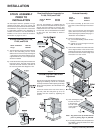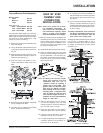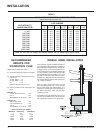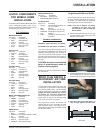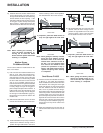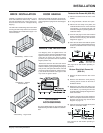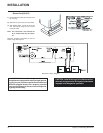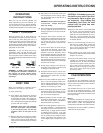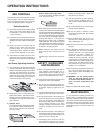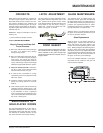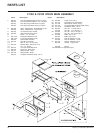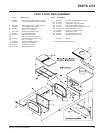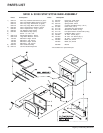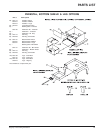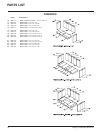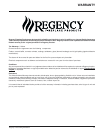
Regency Freestanding Woodstove
20
ASH DISPOSAL
During constant use, ashes should be removed
every few days. The Ash Drawer option fea-
tures a convenient ash dump for easy removal
of ash, see "Modular Options" on page 9.
Safety Precautions
1) Do not allow ashes to build up to the loading
doors! Only remove ashes when the fire
has died down. Even then, expect to find
a few hot embers.
2) Please take care to prevent the build-up of
ash around the start-up air housing located
inside the stove box, under the loading door
lip.
3) Never start a fire if the ash plug and ash
drawer are not in place. This will cause
overfiring which can cause excessive
warping of the stove. Evidence of overfir-
ing can void the warranty on your stove.
4) The firebricks are brittle and can be dam-
aged if the plug is replaced carelessly or
pieces that are too large are forced through
the hole.
Ash Drawer Operating Guideline
1) Only clean ashes out of the stove when the
unit has cooled down. Remove the plug by
lifting on the handle using the tool provided.
The plug may still be warm, use caution.
Push the ashes down the hole into the ash
drawer, the large pieces can be left in the
firebox and burned during the next fire or
removed through the door opening.
OPERATING INSTRUCTIONS
2) Always leave 1/2 to 1 inch of ash in the
bottom of the firebox. This helps in easier
starting and a more uniform burn of your
fire. Replace ash plug when ashes have
been removed.
3) Pedestal Units:
To remove the drawer, lift slightly and slide
it out. When the drawer is completely out,
slide the cover plate over the ash drawer
and carry away.
Bottom Shield (with Legs) Units:
To remove the drawer, lift slightly and slide
it out, and carry it away.
4) When emptying the ash drawer, make sure
the ashes are cold. Ashes should be placed
in a metal container with a tight fitting lid. The
closed container of ashes should be placed
on a non-combustible floor or on the ground,
well away from all combustible materials,
pending final disposal. If the ashes are
disposed of by burial in soil or otherwise
locally dispersed, they should be retained
in the closed container until all cinders have
thoroughly cooled. Other waste should not
be placed in the ash container.
5) Before putting the ash drawer back into
place, make sure the ash plug is back in
place.
Pedestal Units: make sure the cover lid is
off.
SAFETY GUIDELINES
AND WARNINGS
1) Never use gasoline, gasoline type lantern
fuels, kerosene, charcoal lighter fuel, or
similar liquids to start or ‘freshen up’ a fire
in your heater. Keep all such liquids well
away from the heater while it is in use.
2) Keep the door closed during operation and
maintain all seals in good condition.
3) Do not burn any quantities of paper, gar-
bage, and never burn flammable fluids such
as gasoline, naptha or engine oil in your
stove.
4) If you have smoke detectors, prevent smoke
spillage as this may set off a false alarm.
5) Do not overfire heater. If the chimney con-
nector, flue baffle or the stove top begin to
glow, you are overfiring. Stop adding fuel
and close the draft control. Overfiring can
cause extensive damage to your stove
including warpage and premature steel
corrosion. Overfiring will void your war-
ranty.
6) Do not permit creosote or soot build-up in
the chimney system. Check and clean chim-
ney at regular intervals. Failure to do so can
result in a serious chimney fire.
7) Your Regency stove can be very hot. You
may be seriously burned if you touch the
stove while it is operating, keep children,
clothing and furniture away. Warn chil-
dren of the burn hazard.
8) The stove consumes air while operating,
provide adequate ventilation with an air
duct or open a window while the stove is
in use.
9) Do not connect this unit to a chimney flue
serving another appliance.
10)Do not use grates or andirons or other
methods for supporting fuel. Burn directly
on the bricks.
11)Open the draft control fully for 10 to 15
seconds prior to slowly opening the door
when refuelling the fire.
12)Do not connect your unit to any air distribu-
tion duct.
13)Your woodstove should burn dry, stand-
ard firewood only. The use of cut lumber,
plywood, “mill ends”, etc. is discouraged
as this fuel can easily overheat your
woodstove. Evidence of excessive over-
heating will void your warranty. As well,
a large portion of sawmill waste is chem-
ically treated lumber, which is illegal to burn
in many areas. Salt drift wood and chem-
ically treated fire logs also must not be
burned in your woodstoves.
14)Do not store any fuel closer than 2 feet from
your unit. Do not place wood, paper, fur-
niture, drapes or other combustibles near
the appliance.
15) WARNING: Do not operate without
either the Ash Plug properly seated
or the Ash Dump Plates screwed in
place, excessive temperatures will
result.
16)Do not operate with broken glazing.
MAINTENANCE
It is very important to carefully maintain your
fireplace stove, including burning seasoned
wood and maintaining a clean stove and chim-
ney system. Have the chimney cleaned before
the burning season and as necessary during
the season, as creosote deposits may build up
rapidly. Moving parts of your stove require no
lubrication.



